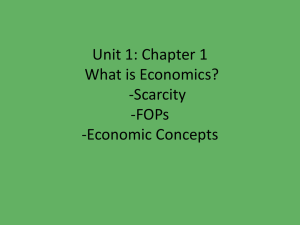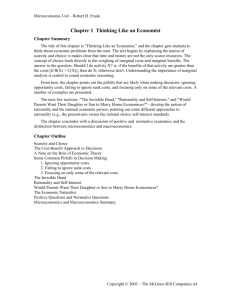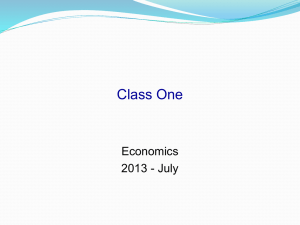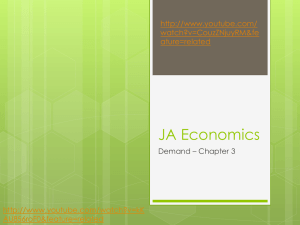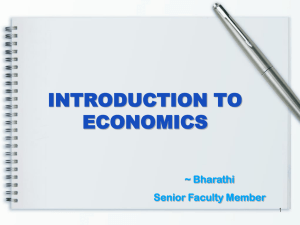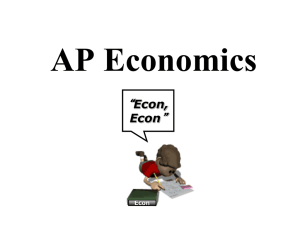Chapter 1 of the IM
advertisement
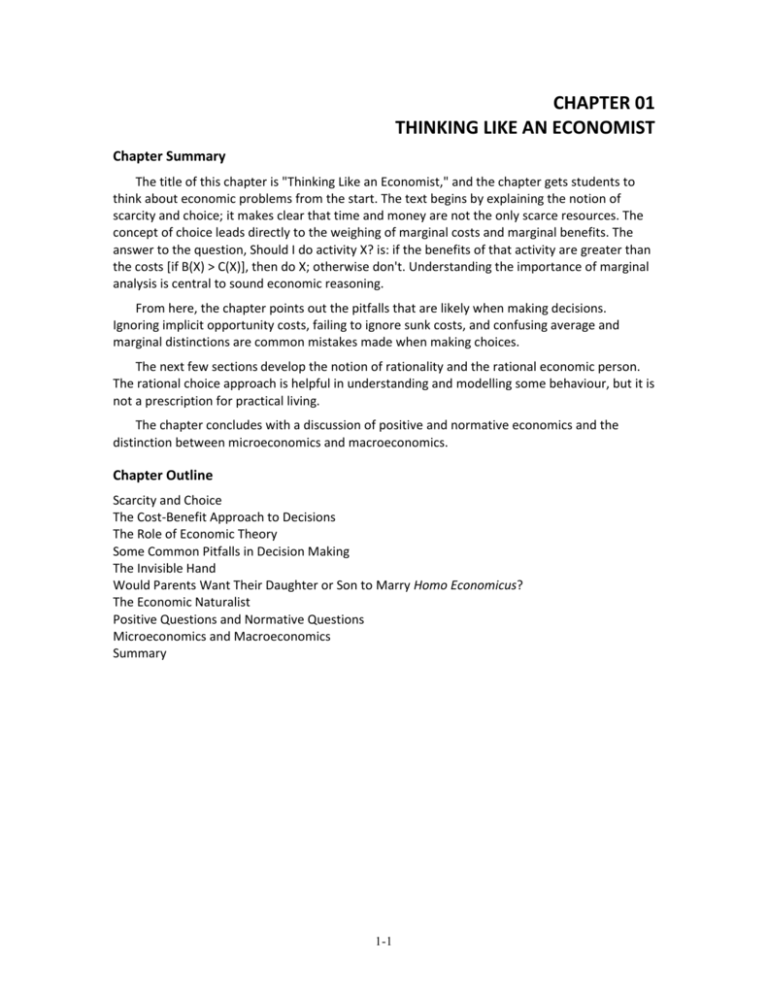
CHAPTER 01 THINKING LIKE AN ECONOMIST Chapter Summary The title of this chapter is "Thinking Like an Economist," and the chapter gets students to think about economic problems from the start. The text begins by explaining the notion of scarcity and choice; it makes clear that time and money are not the only scarce resources. The concept of choice leads directly to the weighing of marginal costs and marginal benefits. The answer to the question, Should I do activity X? is: if the benefits of that activity are greater than the costs [if B(X) > C(X)], then do X; otherwise don't. Understanding the importance of marginal analysis is central to sound economic reasoning. From here, the chapter points out the pitfalls that are likely when making decisions. Ignoring implicit opportunity costs, failing to ignore sunk costs, and confusing average and marginal distinctions are common mistakes made when making choices. The next few sections develop the notion of rationality and the rational economic person. The rational choice approach is helpful in understanding and modelling some behaviour, but it is not a prescription for practical living. The chapter concludes with a discussion of positive and normative economics and the distinction between microeconomics and macroeconomics. Chapter Outline Scarcity and Choice The Cost-Benefit Approach to Decisions The Role of Economic Theory Some Common Pitfalls in Decision Making The Invisible Hand Would Parents Want Their Daughter or Son to Marry Homo Economicus? The Economic Naturalist Positive Questions and Normative Questions Microeconomics and Macroeconomics Summary 1-1 Teaching Suggestions 1. Begin the term / semester with a view of the "forest"_ the course seen as a whole. It is very easy to get lost in the "trees" of individual topics, especially when it takes three weeks to derive a demand curve. A flow-chart which you come back to at various times during the term can be useful to make sure students know where we were and where we are going next. The chart below is an example of what might work. 2. One of the strengths of the Microeconomics and Behaviour book is its recognition that economic thinking does not predict as much human behaviour as the "rational choice" stereotype might have students believe. This means that the methodology of economics is very important to understand. To illustrate this point you can set up a game such as the following. Students are split into pairs. Have seven ping-pong balls numbered 1,1,2,2,3,4,5. One student in each pair will pick a number from one to five, and then the other student will pick a number from one to five. You then randomly pick a ping-pong ball. The student in each pair who is closest to the randomly picked number will get 100 fictitious euros (real euros for rich departments). If the students are equidistant from the selected ball or pick the same number, they will split the 100 euros evenly. 1-2 A rational choice model will predict that (unless risk loving) both students will pick a 2 because the expected value of the 2 is €50, which is higher than the expected value of any other option. For example, if the first person picks a 1, the second person should pick 2; so a 1 would bring an expected return of 2/7 of €100 or €28. If the first person picks 3, the second person should again pick 2; so, a 3 would bring a probability of winning of 3/7 or still less than €50. A risk lover could choose a number other than 2 because it is the only chance to get the €100. It is interesting when the numbers are tallied because invariably some, usually a minority, pick numbers other than 2. What can we get from the discussion that follows playing the game: (a) Economic theory makes a particular prediction of what is best. It answers a positive economic question with a direct answer. With knowledge a student may have chosen a different number. (b) Many students behave according to the prediction even if they did not consciously work out all the calculations. (c) Some did not behave according to the prediction. You can ask why not, and whether behaviour would change with experience. If time permits, it is helpful to have the students read Friedman's classic methodological article and then rate this ping-pong model on the characteristics of robustness, simplicity, and fruitfulness. Note that this game would clearly be relevant for Chapter 8 as well. And its always nice to have an economic story behind the game, and product differentiation is one possibility: the students are sellers of a good that can be different types from 1 to 5; they need to decide what to produce/advertise, an important buyer will then compare the offering of the two sellers and buy from the one closest to her needs. Stumbling Blocks for Students 1. Economists assume that students really want to "think like economists." Far better to assume that they will have to be convinced that such thinking is important. All of the examples in this chapter are showing not only how economists think, but why students may want to think that way also. Doesn't the mind work all this out unconsciously? Can't I trust my gut feeling about whether I should go skiing or not? Are we simply predicting the obvious? Point out that counter intuitive outcomes in economic thinking are plentiful. 2. Cost-benefit analysis of daily events seems too mechanical to most students. Everyone has enough Veblen in them to feel put off by the quantification of quality of life trade-offs. Perhaps they might understand a bit when they consider how carefully they analyse decisions like marriage, religion, and occupation. On what basis do the students decide whether or not they should buckle their seat belts? 3. It is not immediately obvious to most that there is a vast difference between marginal and total or average analysis. The definitions will need to be illustrated with many examples. Later on when production and cost topics are studied the rewards of working with marginal analysis here will pay off. 4. Be sure to clarify what a reservation price is. It is not a household word to students since each customer pays the same price for a commodity in single price markets. The concept is helpful later when consumer surplus and welfare are considered. 1-3 Additional Problems 1. Bob has decided to go skiing for the weekend, but (absentminded professor that he is) he has forgotten his skis. He is considering three options: (1) stay indoors and read economics texts; (2) ski for two days and read economics texts one day; (3) ski for three days and forget economics. The costs of skiing are as follows: Transportation €100 Lodging €200 Ski pass € 20 per day Ski rental € 25 per day Bob has also found out that the resort has a special three-day pass including ski rental for €75. Assume that Bob has already reached the ski slopes and that he cannot cancel his room reservations. a. What are the costs of the three options? b. What is the cost of skiing a third day? c. Suppose Bob figures it is worth about €30 a day for him to ski. What should he do? 2. Joe is a full-time student who moonlights at night washing dishes. He makes €8 an hour after taxes, but he's decided that his nocturnal activities are hurting his grades. He figures that by studying two extra hours a week he could raise his grade in economics from a B to an A next semester. If a semester is 15 weeks long and if Joe is unwilling to give up any other activities, how much will his A cost? 3. Barbara and Zellah hope to go to Miami Beach for spring break for seven days. Since both are rational economic women, they have calculated the costs of flying vs. driving. Flying: Airline ticket is €150 per person, and a car rental is €25 per day. Driving their own car: Gas is €100, lodging to Miami Beach and back is €150 for a double room, and wear on the car is €200. a. Which option costs less? b. Zellah also says that she hates driving. Should one include this distaste as a cost? 4. During the gasoline crunch in the mid and late seventies, the price of gas was kept below the market-clearing price. Often this policy resulted in long lines. Assume two possible states of the world in the seventies: (1) Gas costs €1 a gallon with no waiting; (2) gas costs €0.60 a gallon but one must wait for half an hour to get it. a. Trevor Goodwood, an attorney at a prestigious law firm, hates waiting in line. He figures his time is worth €100 an hour. His gas tank holds 20 gallons. How much does gas cost per gallon in the two scenarios given above? Which would Trevor prefer? b. Howard Outoluck is unemployed and figures his time is worth nothing. He also has a 20-gallon tank. Which option does he prefer? 5. Jack and Jill are going on a date to Funland, a local amusement park which has recently opened. Funland charges €10 admission to the park plus €2 for each ride. Each ride requires a 20-minute wait and lasts 10 minutes. Jack and Jill figure that her time is worth €18 an hour and his is worth €12. 1-4 a. If they each decide to take ten rides what is the total cost for Jack? For Jill? b. What is the cost of one additional ride for both Jack and Jill? 6. Rational choice theory assumes that you calculate the costs and benefits of getting out of bed every morning. When the benefits outweigh the cost of getting up you get up. Yet most never consciously make such calculations. How does Milton Friedman justify economic models that make such unrealistic assumptions? 7. Paul came back to the office frustrated because his committee meeting had gone 15 minutes overtime. Later he flew to Japan on business and emailed how pleased he was that his flights went well and that he arrived only 15 minutes late. In each case he lost 15 minutes so why the different reaction? Answers to Additional Problems 1. a) The opportunity cost of option one is zero since transportation and lodging represent sunk costs. Bob must, however, give up skiing in order to read economics. Option two costs €75 since the three-day pass is cheaper than the per day rate for two days; in addition Bob gives up one day of studying economics. Option three costs €75 plus the loss of three days of studying economics. 1. b) The loss of one day to study economics. 1. c) Ski all three days since €75 for three days works out to €25 a day. 2. €8 x 2 hr per week x 15 weeks in a semester equals €240. 3. a) Option one costs €300 plus €175 = €475. Option two costs €450. b) Yes. The saving from option two is only €25. If Zellah is willing to pay €25 to avoid driving, then they should fly. (Note: Flying will cost Barbara an additional €12.50; Zellah could pay Barbara this amount.) 4. a) Under the first scenario gas costs €1 per gallon. If Trevor must wait half an hour, then it costs him €50 plus €12 for the 20 gallons; his cost per gallon is €3.10. Thus Trevor prefers to pay €1.00. 4. b) Howard doesn't mind waiting in line; he prefers to pay €0.60. 5. a) Jack: €10 admission plus 10 x €2 for each ride plus €12 x 5 for his time; the total cost is €90. Jill: €10 admission plus 10 x €2 for each ride plus €18 x 5 for her time; the total cost is €120. 5. b) Jack: €2 plus €12 x 1/2 for his time; it costs €8. Jill: €2 plus €18 x 1/2 for her time; it costs €11. 6. Friedman claims that you act as if you made the calculations so that someone who has good data on your preferences and opportunity costs can estimate your costs of lying in bed and compare them to your benefits of getting up and predict with reasonable certainty when you will get up. 1-5 7. The committee was supposed to last one hour and the flight 14 hours. Our minds work with proportions in most cases and so Paul’s reactions are inconsistent with rational choice theory. 1-6 HOMEWORK ASSIGNMENT NAME:______________________________ 1. You have had five equally weighted tests in a course and your test average in the class has unfortunately fallen from 90 to 88 to 84 to 81 to 79 where it is now. What score did you get on each exam? You have a final left that is weighted the same as the other tests. What is the highest grade you can possibly get in the course if the six exams are all of the grade? What does this tell you about average and marginal test scores? 2. Most people conclude that the costs outweigh the benefits of dealing with grievances by a suicide bombing attack. Yet some willingly engage in such activity. Are they miscalculating or do they value costs and benefits differently? Explain. What does this tell us about cost-benefit analysis? 3. A Wall Street Journal article told how most short order food restaurants are going to the single winding (serpentine) queuing line for their customers even though it is less efficient than the self-forming series of lines at the counter. Why do you think this economically irrational behaviour is occurring? 4. Find a newspaper clipping which relates to one point of the chapter outline shown in this chapter. Identify which outline point is involved and how the story relates to it. 5. Based on this chapter, consider why political decisions often seem inefficient and inconsistent with good economic thinking? Give one specific example to illustrate your answer. 1-7 Answers to Homework Assignment HOMEWORK ASSIGNMENT KEY:______CHAPTER 1__________ 1. You have had five equally weighted tests in a course and your test average in the class has unfortunately fallen from 90 to 88 to 84 to 81 to 79 where it is now. What score did you get on each exam? You have a final left that is weighted the same as the other tests. What is the highest grade you can possibly get in the course if the six exams are all of the grade? Your total score goes from 90 to 176 to 252 to 324 to 395. The differences between each total shows how much the last exam pushed up the total. Accordingly, the test scores respectively are 90, 86, 76, 72, 71. If you got 100 on the final you would have 495 point which when divided by 5 leaves a course average of 82.5%. This shows that whenever the marginal exam score is below the average it pulls the average down and whenever it is above the average it pulls the average up. 2. Most people conclude that the costs outweigh the benefits of dealing with grievances by a suicide bombing attach. Yet some willingly engage in such activity. Are they miscalculating or do they value costs and benefits differently? Explain. What does this tell us about cost-benefit analysis? Most likely suicide bombers have a different value system than most. They may be part of a religious group that sees death as desirable and a suicide death as meritorious. It is possible that they may have overestimated the benefits of their act as well as underestimated the costs. This does illustrate that it is hard to separate values from what is thought to be value free analysis. 3. A recent Wall Street Journal article told how nearly all short order food restaurants are going to the single winding queuing line for their customers even though it is less efficient than the self-forming series of lines at the counter. Why do you think this economically irrational behaviour is occurring? People are letting emotions and a sense of justice dominate their desire for efficiency. They hate to see someone who came later than them be served first. 4. Find a newspaper clipping which relates to one point of the chapter outline shown in this chapter. Identify which outline point is involved and how the story relates to it. It should not be hard to find stories of behaviour that follow a predictable pattern based on the self-interested pursuit of objectives common to most. It pays to be a generous grader on a question like this, particularly early in the term. It might be good to use some questionable answers in class to clarify the point. 5. Based on this chapter, consider why political decisions often seem inefficient and inconsistent with good economic thinking? Give one specific example to illustrate your answer. 1-8 Because the public is so prone to the pitfalls listed in this chapter and because politicians get elected based on what people are feeling, it is necessary to cater to those feelings and propose policies that satisfy them. An example would be thinking of government spending as billions of dollars rather than as proportions of GDP or the federal budget. Many policies suffer from one or more of the pitfalls listed in your chapter. 1-9
